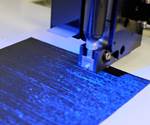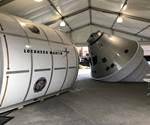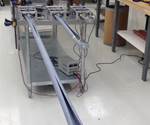Haydale receives funding to develop composite gas tanks for space propulsion
Following an initial study last year, the company will test materials and processes for development of storage tanks for use on satellite propulsion systems.

Source | Haydale
Haydale Graphene Industris Plc., (Ammanford, U.K.), a global advanced materials group, has been awarded funding from the European Space Agency (ESA, Paris, France) to develop composite gas tanks for spacecraft propulsion systems.
The company says its composite storage system will be a low-cost solution for the growing market for small spacecraft constellations — large groups of low-orbit satellites launched at one time, intended to spread global communication without the need for ground-based transmitters. Haydale says that its components meet the need in the existing space propulsion supply chain for low-cost, reliable components that also offer rapid delivery schedules and support ongoing reduction of orbital debris. Haydale’s system can be offered in a range of configurations for various requirements.
The ESA award follows the successful outcome of an ESA General Support Technology Programme (GSTP) project in 2018 performed with ESA and the UK Space Agency, which was titled “Assessments to Prepare and De-Risk Technology Developments — Tank using Advanced Composites.”
With the new funding, Haydale plans to develop findings from the GSTP project, performing comprehensive tests to determine the best material and process for developing composite gas tanks. After selection of both material and process, Haydale says it will formulate and model a largely de-risked tank, followed by manufacture of development models for full testing. This will result in the qualification for specific spacecraft propulsion systems.
Haydale says its tanks will offer leak-free storage and delivery on demand of all propellant and pressurized gases stored within, under specified environmental conditions and expected transient load cases; high-pressure storage capabilities, with required levels of safety and reliability; and reliable connections to the feed system and mechanical mounting.
Haydale is working on this project in collaboration with ISP International Space Propulsion Ltd. (Wiltshire, U.K.) through the ESA ARTES Competitiveness & Growth, in conjunction with UK Space Agency. The company says that Airbus DS Tank Product Group is also involved in the project. The company has identified satellite technology producers for developing the specification and tank design for eventual manufacture and deployment.
“This funding will allow Haydale to develop existing knowledge in the space industry and we look forward to developing the technology alongside our partners,” says Keith Broadbent, CEO of Haydale.
Related Content
-
Plant tour: Daher Shap’in TechCenter and composites production plant, Saint-Aignan-de-Grandlieu, France
Co-located R&D and production advance OOA thermosets, thermoplastics, welding, recycling and digital technologies for faster processing and certification of lighter, more sustainable composites.
-
Recycling end-of-life composite parts: New methods, markets
From infrastructure solutions to consumer products, Polish recycler Anmet and Netherlands-based researchers are developing new methods for repurposing wind turbine blades and other composite parts.
-
Composites end markets: Electronics (2024)
Increasingly, prototype and production-ready smart devices featuring thermoplastic composite cases and other components provide lightweight, optimized sustainable alternatives to metal.

.jpg;width=70;height=70;mode=crop)













